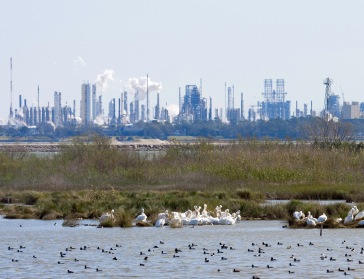Even though they’re meant to stimulate the lagging economy, the word “stimulus” wasn’t in evidence last week in President Barack Obama’s announcement that he would promote tax breaks for small businesses and more spending on the nation’s transportation system.
 As NPR’s Juan Williams commented on Sunday, “That word has been so poisoned in the political lexicon of today that he can’t afford to have any additional economic initiative dubbed a stimulus. It’s just like a sign of death on arrival.”
As NPR’s Juan Williams commented on Sunday, “That word has been so poisoned in the political lexicon of today that he can’t afford to have any additional economic initiative dubbed a stimulus. It’s just like a sign of death on arrival.”
The minefield of current political vocabulary is not, of course, doing anything to stop the flow of stimulus grants, already in the federal funding pipeline, to Texas projects aimed at addressing climate-changing emissions of carbon dioxide. CO2 is the main human-produced greenhouse gas.
Last week, for instance, federal officials announced that Texas recipients would get two of 22 new grants aimed at speeding research and development of technologies for capturing and storing carbon from industrial sources.
The two $5 million grants to the University of Texas and to Houston-based Sandia Technologies are part of $575 million in funding for 22 projects in 15 states to accelerate such work on “carbon capture and storage,” commonly known as CCS, the U. S. Department of Energy announced. The money came from the American Recovery and Reinvestment Act, the huge “stimulus bill” enacted in 2009.
The UT project will evaluate opportunities for storage in geological formations beneath the Gulf of Mexico. It will use seismic imaging to develop data that will help assess the formations so they might be used for injecting carbon, the DOE said.
Sandia Technologies, a privately owned engineering and consulting company with expertise in the realm of underground carbon storage, will investigate opportunities for injecting industry-produced carbon in the Newark Basin area of New York and New Jersey.
A DOE press release quoted Energy Secretary Steven Chu regarding the 22 grants: “This is a major step forward in the fight to reduce carbon emissions from industrial plants. These new technologies will not only help fight climate change, they will create jobs now and help position the United States to lead the world in clean coal technologies, which will only increase in demand in the years ahead.”
The new grants brought DOE’s total investment in CCS projects to more than $4 billion, matched by $7 billion in private funding, Chu said.
The two Texas grants were in one of the four categories for the new CCS grants – characterization of geologic storage sites. The other three categories involved advanced technologies for converting carbon-based fuels into synthetic gas, advanced machinery to reduce industrial emissions and technologies to capture CO2 at the source.
The Associated Press provided this context in its report on the 22 grants:
[…] Obama wants a cost-effective deployment of carbon capture and storage within 10 years — despite questions about the technology and skepticism about its feasibility. He created a task force this year charged with coming up with a plan to overcome barriers to such deployment.
One issue identified by the task force was liability, because a sudden release of large amounts of carbon dioxide can kill by asphyxiation. The task force called for several options to be considered: maintaining the current legal framework; putting limits on claims; establishing an industry-financed trust fund to pay damages after a site is closed; or transferring of liability to the federal government following a site closure, under certain conditions.
Austin’s KUT reported that Tip Meckel, a UT research associate heading the university’s project, said it makes sense to explore carbon-storage possibilities beneath the Gulf because of the large number of refineries and other industrial sources that release CO2 to the atmosphere near the Gulf coast.
The public radio station called the grant “‘clean coal’ money,” noting that the DOE is pursuing CCS projects as part of Obama’s promise to find ways to make coal use more climate-friendly and cleaner.
Cyrus Reid, conservation director of the Sierra Club’s Austin-based Lone Star Chapter, told KUT, however, that the organization objects to the very term “clean coal,” asserting that it is misleading in light of coal’s many negative impacts on the environment and people’s health, and wants a transition from coal to alternative energy sources instead. One objection to even lower-impact utilization of coal is that it still generates huge volumes of coal ash, a hazardous byproduct.
Disposal of coal waste has been increasingly controversial since a Tennessee Valley Authority plant spilled an estimated 1.1 billion gallons of ash-water slurry in late 2008. The dispute was manifest in Texas last week: Sierra Club members and other environmentalists from Texas and surrounding states converged on an Environmental Protection Agency hearing in Dallas to call for tougher regulation of coal-ash disposal.
Such environmental dilemmas are hardly confined to the U.S.
Journalist Peter Fairley, writing in the September/October issue of MIT’s Technology Review magazine, reported on China’s new program to address its shortage of domestic oil and booming automobile market with efforts to convert domestic coal to vehicle fuels:
The process makes economic sense but inflicts an environmental double whammy. Simply making the fuel produces prodigious amounts of carbon dioxide, even before the fuel itself is burned. It also uses enormous amounts of another scarce Chinese commodity: water.
[…]
To try to mitigate emissions, [coal producer] Shenhua has started a small carbon sequestration project that is expected to inject 100,000 tons of carbon dioxide into a deep saline aquifer by the end of this year. Its vast plant can potentially capture 2.9 million tons of carbon dioxide annually – about four-fifths of the plant’s emissions.
– Bill Dawson
